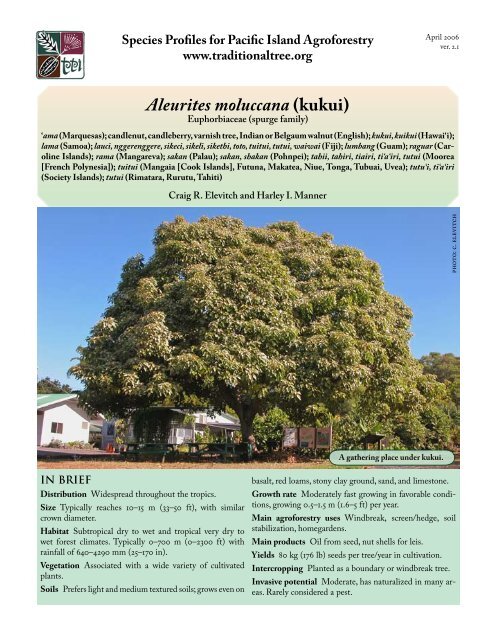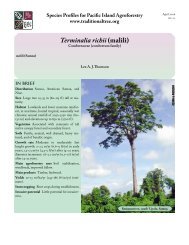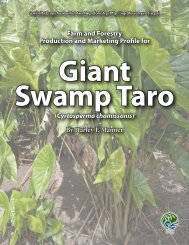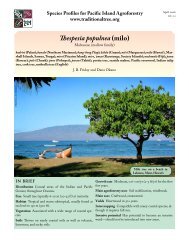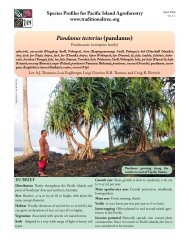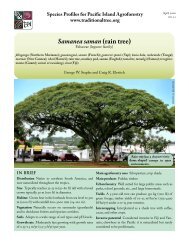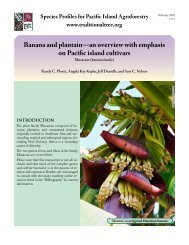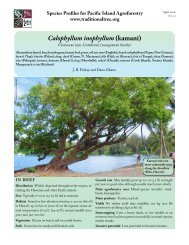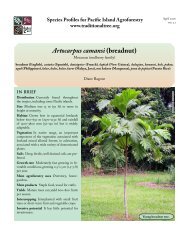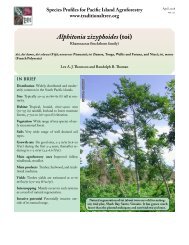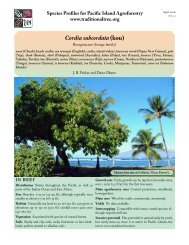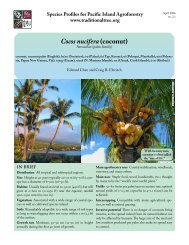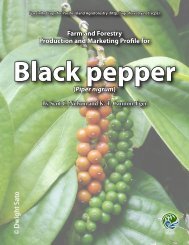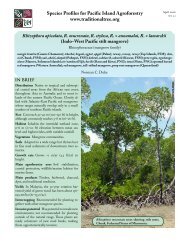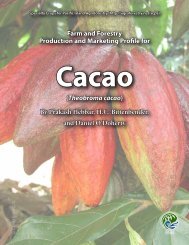Aleurites moluccana (Kukui) - Agroforestry Net
Aleurites moluccana (Kukui) - Agroforestry Net
Aleurites moluccana (Kukui) - Agroforestry Net
Create successful ePaper yourself
Turn your PDF publications into a flip-book with our unique Google optimized e-Paper software.
IN BRIEF<br />
Species Profiles for Pacific Island <strong>Agroforestry</strong><br />
www.traditionaltree.org<br />
Distribution Widespread throughout the tropics.<br />
Size Typically reaches 10–15 m (33–50 ft), with similar<br />
crown diameter.<br />
Habitat Subtropical dry to wet and tropical very dry to<br />
wet forest climates. Typically 0–700 m (0–2300 ft) with<br />
rainfall of 640–4290 mm (25–170 in).<br />
Vegetation Associated with a wide variety of cultivated<br />
plants.<br />
Soils Prefers light and medium textured soils; grows even on<br />
<strong>Aleurites</strong> <strong>moluccana</strong> (kukui)<br />
Euphorbiaceae (spurge family)<br />
‘ama (Marquesas); candlenut, candleberry, varnish tree, Indian or Belgaum walnut (English); kukui, kuikui (Hawai‘i);<br />
lama (Samoa); lauci, nggerenggere, sikeci, sikeli, sikethi, toto, tuitui, tutui, waiwai (Fiji); lumbang (Guam); raguar (Caroline<br />
Islands); rama (Mangareva); sakan (Palau); sakan, shakan (Pohnpei); tahii, tahiri, tiairi, ti‘a‘iri, tutui (Moorea<br />
[French Polynesia]); tuitui (Mangaia [Cook Islands], Futuna, Makatea, Niue, Tonga, Tubuai, Uvea); tutu‘i, ti‘a‘iri<br />
(Society Islands); tutui (Rimatara, Rurutu, Tahiti)<br />
Craig R. Elevitch and Harley I. Manner<br />
basalt, red loams, stony clay ground, sand, and limestone.<br />
Growth rate Moderately fast growing in favorable conditions,<br />
growing 0.5–1.5 m (1.6–5 ft) per year.<br />
Main agroforestry uses Windbreak, screen/hedge, soil<br />
stabilization, homegardens.<br />
Main products Oil from seed, nut shells for leis.<br />
Yields 80 kg (176 lb) seeds per tree/year in cultivation.<br />
April 2006<br />
ver. 2.1<br />
A gathering place under kukui.<br />
Intercropping Planted as a boundary or windbreak tree.<br />
Invasive potential Moderate, has naturalized in many areas.<br />
Rarely considered a pest.<br />
photo: C. ElEvitCh
INTRODUCTION<br />
<strong>Kukui</strong> is one of the great domesticated multipurpose trees<br />
of the world. It is one of the most useful trees introduced by<br />
the aboriginal people of the Pacific islands. A tall, spreading<br />
tree in open areas, it commonly attains heights of 10 m<br />
(33 ft) and a canopy diameter about as wide as the tree<br />
is tall. <strong>Kukui</strong> grows in homegardens, in and around farms,<br />
and naturalized along streams, gulches, and valley slopes. It<br />
is easily recognized by its characteristic silvery gray-green<br />
foliage, which is particularly ornamental.<br />
<strong>Kukui</strong> is native to the Indo-Malaysia region and was introduced<br />
in ancient times throughout the Pacific islands. It<br />
can grow in a wide range of dry to wet tropical and subtropical<br />
habitats but is most at home in the moist tropics<br />
with annual rainfall of 2000 mm (80 in) or greater. <strong>Kukui</strong><br />
tolerates drought and wind and grows readily on poor soils<br />
as well as steep slopes. Due to its many traditional uses and<br />
its role in ecosystems, kukui is recognized as the official<br />
state tree of Hawai‘i.<br />
The traditional uses of kukui are extensive. Throughout<br />
Polynesia kukui is known in local languages by names<br />
whose root means “light,” referring to the traditional use<br />
of seeds and oil which were burned for illumination. Many<br />
parts of the plant including the seeds, leaves, flowers, and<br />
bark were used in traditional medicine. Caution is advised<br />
in using the plant medicinally or for consumption, as all<br />
parts of the tree are toxic. Dyes extracted from various<br />
plant parts were used to color tapa cloth and canoes, as<br />
well as in tattooing. Today, in addition to its traditional<br />
uses, kukui has found commercial uses, particularly in the<br />
cosmetics industry.<br />
In urban areas, kukui makes a lovely shade tree or visual<br />
screen. In agricultural systems it can be integrated for use<br />
in windbreaks, shade, soil stabilization, and improved fallow.<br />
<strong>Kukui</strong> can regenerate and naturalize where planted,<br />
and it has been described as a moderate invader in certain<br />
areas. However, it is rarely considered invasive or problematic.<br />
DISTRIBUTION<br />
Native range<br />
<strong>Kukui</strong> is native to Indo-Malaysia. It thrives in moist tropical<br />
regions up to 1200 m (3940 ft) elevation.<br />
Current distribution<br />
<strong>Kukui</strong> is today widespread throughout the tropics. It was<br />
introduced aboriginally throughout the Pacific islands and<br />
is now a common tree of the Pacific at elevations up to 700<br />
<strong>Aleurites</strong> <strong>moluccana</strong> (kukui)<br />
m (2300 ft). In Hawai‘i, kukui has naturalized in forests<br />
on all the main islands and is commonly found in cultivation.<br />
It is particularly at home in moderately moist valleys,<br />
where it has become a conspicuous part of the landscape.<br />
Elsewhere in the Pacific, it is primarily found in cultivation<br />
in villages and plantations or in secondary growth following<br />
cultivation or along stream banks. The tree is also found<br />
in Puerto Rico, the Virgin Islands, Malagasy, Sri Lanka,<br />
southern India, Bangladesh, Brazil, the West Indies, and<br />
the Gulf Coast of the United States.<br />
BOTANICAL DESCRIPTION<br />
Preferred scientific name<br />
<strong>Aleurites</strong> <strong>moluccana</strong> (L.) Willd.<br />
Family Euphorbiaceae (spurge family)<br />
Non-preferred scientific names<br />
Synonyms no longer in use include:<br />
<strong>Aleurites</strong> javanica Gand.<br />
<strong>Aleurites</strong> remyi Sherff<br />
<strong>Aleurites</strong> triloba Forster & Forster f.<br />
Camirium moluccanum (L.) Ktze.<br />
Croton moluccanus L.<br />
Jatropha <strong>moluccana</strong> L.<br />
Common names<br />
Candlenut, candleberry, varnish tree, Indian or Belgaum<br />
walnut (English)<br />
The roots of the Polynesian names below mean “light,” referring<br />
to the ancient use of burning the nuts or oil extracted<br />
from the nuts to provide illumination:<br />
‘ama (Marquesas)<br />
kukui, kuikui (Hawai‘i)<br />
lama (Samoa)<br />
rama (Mangareva)<br />
tahii, tahiri, tiairi, ti‘a‘iri, tutui (Moorea, French Polynesia)<br />
tuitui (Mangaia [Cook Islands], Futuna, Makatea, Niue,<br />
Tonga, Tubuai, Uvea)<br />
tutu‘i, ti‘a‘iri (Society Islands)<br />
tutui (Rimatara, Rurutu, Tahiti)<br />
Other common names from the Pacific include:<br />
lauci, nggerenggere, sikeci, sikeli, sikethi, toto, tuitui, tutui,<br />
waiwai (Fiji)<br />
lumbang (Guam)<br />
raguar (Caroline Islands)<br />
sakan (Palau)<br />
sakan, shakan (Pohnpei)<br />
Names from other world regions include:
Left: <strong>Kukui</strong> often is found in the regrowth of abandoned agricultural sites, such as here in American Samoa. (pictured: Tuipuavai<br />
Tago) Right: The distinctive canopy often stands out in the landscape, such as here on the slopes of Waipi‘o Valley,<br />
Hawai‘i. photos: C. ElEvitCh<br />
arbol llorón, avellano, avellano criollo, nogal de la India, nuez<br />
(Spanish)<br />
bancoulier, noyer de bancoul, noyer des Moluques, aleurites,<br />
noisette, noix, noyer, noyer des Indes (French)<br />
calumbàn, noz da India (Portuguese)<br />
kamiri (Indonesian)<br />
kandeltri (Bislama, Vanuatu)<br />
Kerzennussbaum, Lichtnussbaum (German)<br />
le noix de Bancoul (French, Vanuatu)<br />
lèrit, nwa, nwazèt (Creole)<br />
ragaur (Carolinian)<br />
tung (trade name)<br />
Size and form<br />
<strong>Kukui</strong> is a large spreading tree that can reach 20 m (66 ft)<br />
in height and 0.9 m (3 ft) trunk diameter, although it typically<br />
reaches 10–15 m (33–50 ft) when growing in the open.<br />
Crooked trunks and irregular, wide, spreading or pendulous<br />
side branches are typical. In narrow valleys kukui usually<br />
has a branchless trunk and achieves its greatest height.<br />
Dense clusters of kukui are often seen in areas favorable<br />
to its growth, with the inner trees having tall trunks with<br />
relatively few side branches and trees on the edge having<br />
outer side branches and foliage often down to the ground.<br />
Flowers<br />
<strong>Kukui</strong> is monoecious (having both male and female flowers<br />
on the same plant). The greenish-white, fragrant flowers<br />
are arranged in a 10–15 cm (4–6 in) terminal panicled<br />
cyme, with many small male flowers surrounding the female<br />
flowers. The corolla is whitish with five free petals,<br />
dingy white to creamy in color, oblong in shape and up to<br />
1.3 cm (0.5 in) in length. The ovary is pubescent, superior,<br />
and two-celled, each with one ovule. Staminate flowers are<br />
longer and thinner than pistillate flowers.<br />
The plant typically flowers in the spring, although flowers<br />
can be found nearly any time of year in many areas.<br />
Leaves<br />
This tree is easily discernible by its very distinctive leaves,<br />
which are three- to five-nerved from the base, alternate, and<br />
simple, with entire, wavy margins. The leaf blades are 10–20<br />
cm (4–8 in) long with two glands at the junction of the<br />
Species Profiles for Pacific Island <strong>Agroforestry</strong> (www.traditionaltree.org)
Upper left: The scientific name for kukui, <strong>Aleurites</strong>, comes from the Greek word for “floury,” referring to the dusted-flour appearance<br />
of young leaves and flower buds. Upper right: Trees often flower nearly continuously. Lower right: Ripe fruit in tree.<br />
Lower left: Bark is smooth and light gray in color, often with lichen growth in moist areas. photos: C. ElEvitCh<br />
leaf base and petiole that secrete a sweetish sap. Leaves of<br />
young plants and those of the lower branches are three- to<br />
five-lobed with a rounded, heart-shaped base (subcordate),<br />
while the apex is acute (sharp). Younger leaves are usually<br />
simple and deltoid to ovate in shape. The upper surface of<br />
young leaves is whitish with a silvery gloss, becoming dark<br />
green with age. The underside is rusty stellate-pubescent<br />
when young (having a hairy glossy indument).<br />
Fruit<br />
The green to brownish fruit is a laterally compressed, ovoid<br />
to globose indehiscent drupe 5–6 cm (2–2.4 in) long by<br />
5–7 cm (2–2.8 in) wide. It has also been described as being<br />
“round, hard apple-shaped” with fleshy to leathery husks.<br />
The nuts contain an oil similar to tung oil from <strong>Aleurites</strong><br />
fordii.<br />
<strong>Aleurites</strong> <strong>moluccana</strong> (kukui)<br />
Seeds<br />
The seeds are contained within a hard, black, rough shell<br />
elliptical in shape and about 2.5–3.5 (1–1.4 in) cm long. The<br />
shells are similar in shape and texture to walnuts, although<br />
smaller and thicker. There are about 100–120 seeds (with<br />
shells on, but with husks removed) per kilogram (45–55<br />
seeds/lb).<br />
Similar species<br />
<strong>Aleurites</strong> trisperma Blanco is a small tree similar to kukui (A.<br />
<strong>moluccana</strong>). Unlike kukui, A. trisperma has unlobed leaves<br />
and prominently ridged three-seeded fruits.<br />
GENETICS<br />
Variability<br />
There is great variability in kukui, particularly in the leaves,
which can vary tremendously in size, shape, color, and texture,<br />
even on a single tree. For example, leaves of young<br />
plants and of the lower branches are three- to five-lobed<br />
while older leaves and those of the upper branches are usually<br />
simple and deltoid to ovate in shape. Fruits can range<br />
in size up to 4 cm (1.6 in) in diameter.<br />
Known varieties<br />
The variety aulanii is named for small-fruited plants from<br />
Waipi‘o Valley, Hawai‘i (Wagner et al. 1999). The variety<br />
katoi (mango-leafed kukui) has “narrow, lanceolate leaves<br />
with lateral lobes obscure or absent” (Stuppy et al. undated).<br />
The remyi variety, also the probable result of aboriginal Hawaiian<br />
selection, has “lengthened, simple lanceolate leaves<br />
(with or without obscure lobes) or deeply lobed leaves with<br />
the lateral lobes very narrow and the terminal lobe much<br />
elongated,” while a cultivar from New Caledonia has orbicular<br />
leaves (Stuppy et al. undated). A variety found in<br />
Vanuatu (Maewo) has seeds which can be eaten without<br />
any apparent toxic effect (Walter and Sam 2002).<br />
Culturally important related species<br />
In China, tung oil is produced from <strong>Aleurites</strong> fordii (Stone<br />
1970). In Japan, A. cordata is used for the same purpose,<br />
while other related species are A. montana and A. trisperma<br />
(Anon. undated [2]).<br />
ASSOCIATED PLANT SPECIES<br />
As kukui is an aboriginal introduction to the Pacific islands,<br />
it is generally found in disturbed mesic (moderately moist)<br />
forest habitats. In Hawai‘i, it is very conspicuous along<br />
stream valleys and ravines. However, it can also be found<br />
in association with native species. It is found in cultivated<br />
forest remnants in the Marquesas and other high volcanic<br />
islands of the Pacific.<br />
Associated native species commonly found<br />
On Mangaia (Cook Islands), kukui is found in “disturbed<br />
native” mixed-species forest dominated by the native tree<br />
species Elaeocarpus floridanus and Hernandia moerenhoutiana<br />
(Merlin 1991). Introduced species associated with kukui<br />
include Cocos nucifera, Morinda citrifolia, Hibiscus tiliaceus,<br />
and Psidium guajava.<br />
In Pahole Gulch, O‘ahu, Hawai‘i, kukui is a dominant<br />
species in a forest composed of Diospyros hillebrandii, D.<br />
sandwicensis, Pisonia umbellifera, and P. brunoniana (Mueller-Dombois<br />
and Fosberg 1998). <strong>Kukui</strong> is also a dominant<br />
in non-native forests of the Pahole Gulch Natural<br />
Area, composed of Syzygium cumini, Psidium spp., Schinus<br />
terebinthifolius, and Eucalyptus (Mueller-Dombois and<br />
Hawaiian sayings (Pukui 1983)<br />
He kumu kukui i he‘e ka pīlali.<br />
“A kukui tree oozing with gum.”<br />
(A prosperous person.)<br />
Ka malu hālau loa o ke kukui.<br />
“The long shelter of the kukui trees.”<br />
(A kukui grove shelters like a house.)<br />
Pupuhi kukui—malino ke kai.<br />
“Spewed kukui nuts—calm sea.”<br />
(Pour oil on troubled waters.)<br />
Fosberg 1998).<br />
On Moorea (Fr. Polynesia), kukui, Hibiscus tiliaceus, Rhus<br />
taitensis, and other trees are found on the sides of valleys.<br />
On rocky slopes, kukui is found in association with<br />
indigenous species such as Pisonia umbellifera, Boehmeria<br />
virgata, Pandanus sp., Freycinetia impavida, Hernandia sp.,<br />
Cyclophyllum barbatum, Macaranga sp., Weinmannia parviflora,<br />
Glocihdion sp., Neonauclea forsteri, Ixora moorensis, and<br />
Tarenna sambucina (Mueller-Dombois and Fosberg 1998).<br />
Species commonly associated as aboriginal introduction<br />
in Pacific islands<br />
In Tahiti, kukui is found in the submontane rain and valley<br />
forests in association with native species along with breadfruit<br />
(Artocarpus altilis), mango (Mangifera indica), and<br />
coconut (Cocos nucifera) (Mueller-Dombois and Fosberg<br />
1998).<br />
In the Marquesas, this species is found in formerly cultivated<br />
valley bottomlands. The vegetation here has been<br />
described as a mesophytic (medium moisture) forest<br />
composed largely of food and other useful plants such as<br />
Artocarpus, Annona, Ceiba, Cocos, Citrus, Coffea, Syzygium,<br />
Inga, Inocarpus, Mangifera, Pandanus, Persea, Psidium,<br />
Pometia, and Spondias (Mueller-Dombois and Fosberg<br />
1998, Decker 1992). On Eiao Island (Marquesas), kukui is<br />
found in the gulches with Pisonia grandis, Hibiscus tiliaceus,<br />
Thespesia populnea, Dodonea viscosa, and Annona squamosa<br />
(Mueller-Dombois and Fosberg 1998).<br />
ENVIRONMENTAL PREFERENCES<br />
AND TOLERANCES<br />
Climate<br />
This species has a large geographical distribution. Climati-<br />
Species Profiles for Pacific Island <strong>Agroforestry</strong> (www.traditionaltree.org)
cally it is found in subtropical dry and wet climates and<br />
tropical very dry to wet forest climates. In Hawai‘i, the<br />
species is found between 0 and 700 m (0–2300 ft) (Wagner<br />
et al. 1999). Near the equator, the tree is reported to<br />
grow on a variety of soils up to 2000 m (6560 ft), although<br />
it is more likely that it has an upper limit of about 1200 m<br />
(3940 ft).<br />
Elevation range<br />
0–700 m (0–2300 ft) (Hawai‘i), but can grow up to 1200 m<br />
(3940 ft) closer to equator.<br />
Mean annual rainfall<br />
640–4290 mm (25–170 in) (mean of 14 cases, 1940 mm [76<br />
in]) (Duke 1983)<br />
Rainfall pattern<br />
<strong>Kukui</strong> grows in climates with summer, winter, bimodal,<br />
and uniform rainfall patterns.<br />
Dry season duration (consecutive months with < 0<br />
mm [1. in] rainfall)<br />
3–5 months or longer, as the species is often found along<br />
streams that may have subsurface water even after longer<br />
dry spells<br />
Mean annual temperature<br />
19–27°C (66–81°F)<br />
Mean maximum temperature of hottest month<br />
26–30°C (79–86°F)<br />
Mean minimum temperature of coldest month<br />
8–13°C (46–55°F)<br />
Minimum temperature tolerated<br />
8°C (46°F) (estimate)<br />
Soils<br />
Said to occur on a variety of soils, including red loams,<br />
stony clay ground, sand, and limestone. As evidenced by<br />
its relative absence in Northern Guam (which is underlain<br />
by limestone), kukui does not seem to prefer alkaline soils.<br />
However, its presence on Mangaia, which has Makatea<br />
soils with some limestone, suggests a tolerance of neutral<br />
to slightly alkaline soils. The species is dominant on moist,<br />
well drained acidic soils (perhaps Inceptisols and Andosols)<br />
of the high volcanic islands of the Pacific Basin.<br />
Soil texture<br />
The tree prefers light and medium texture soils (sands, sandy<br />
loams, loams, and sandy clay loams).<br />
<strong>Aleurites</strong> <strong>moluccana</strong> (kukui)<br />
Soil drainage<br />
It requires free drainage.<br />
Soil acidity<br />
It grows in lightly acidic to alkaline soils (pH 5–8).<br />
Special soil tolerances<br />
<strong>Kukui</strong> tolerates infertile soils.<br />
Tolerances<br />
Drought<br />
<strong>Kukui</strong> is quite drought tolerant once well established.<br />
However, it flourishes in moist environments.<br />
Full sun<br />
The tree prefers full sun and can grow as a pioneer species<br />
in open areas with suitable rainfall.<br />
Shade<br />
<strong>Kukui</strong> can grow in a modest amount of shade, up to 25%.<br />
Fire<br />
The species is probably intolerant of fire.<br />
Frost<br />
It is probably intolerant of frost, as it is generally confined<br />
to the lower slopes of pali (steep slopes) that do not experience<br />
frost (up to about 700 m [2300 ft] in Hawai‘i).<br />
Waterlogging<br />
Although the species is an indicator of stream courses, it<br />
favors well drained, moist soils.<br />
Salt spray<br />
<strong>Kukui</strong> tolerates a modest amount of salt spray and is occasionally<br />
found growing near the coast.<br />
Wind<br />
It tolerates both steady and storm winds and makes a suitable<br />
windbreak tree, especially in a multi-row windbreak.<br />
Abilities<br />
Regenerate rapidly<br />
The tree can grow well even on relatively poor sites, provided<br />
ample soil moisture is available, particularly during<br />
establishment.<br />
Coppice<br />
<strong>Kukui</strong> regrows very well even after severe pruning, although<br />
it has a tendency to die after two or more prunings
in quick succession.<br />
Other<br />
<strong>Kukui</strong> is known for its ability to grow well on<br />
slopes, even steep gulches and cliffs.<br />
GROWTH AND<br />
DEVELOPMENT<br />
There is little direct information on the growth<br />
and development of kukui. It is said that the<br />
tree is quick growing and readily colonizes disturbed<br />
gaps and forest margins. Given these<br />
characteristics, kukui probably has growth rates<br />
comparable to other common secondary forest<br />
tree species. The tree requires little attention<br />
once it is established.<br />
Flowering and fruiting<br />
Flowering and fruiting begins at 3–4 years old.<br />
In many places flowering and fruiting take place<br />
almost continuously, frequently with flowers<br />
and fruits of all stages of ripeness occurring on<br />
each tree.<br />
Reaction to competition<br />
<strong>Kukui</strong> can hold its own even in the presence of<br />
grasses and other herbaceous weeds.<br />
PROPAGATION<br />
Propagation of kukui seedlings is easily done<br />
by seed. Although the seeds can take up to 3–4<br />
months to germinate, they are large and quickly<br />
grow into strong, stout seedlings ready for field<br />
planting. Seedlings are not finicky about growing<br />
location (tolerating sun or partial shade),<br />
nor do they require special growing medium<br />
or watering regimes. Due to the quick growth<br />
of germinating seeds into seedlings, seeds lend<br />
themselves to either being direct-seeded in the<br />
field or pregerminated in the nursery, then direct-seeded.<br />
<strong>Kukui</strong> can also be propagated by<br />
cuttings, but this is uncommon and may not<br />
yield a plant that grows as vigorously as a seedling.<br />
Seed collection<br />
<strong>Kukui</strong> flowers and fruits intermittently throughout the<br />
year. Mature fruits can be picked from the tree or collected<br />
from the ground.<br />
Ripe fruit can often be collected from underneath the lower canopy (top),<br />
or seeds can be collected from the ground under trees with the husk already<br />
deteriorated (bottom). photos: C. ElEvitCh<br />
Seed processing<br />
If the fruits are fresh, they are allowed to decay a few<br />
days in a moist area, which facilitates peeling off the thick,<br />
leathery outer husk. This exposes the hard shell that encloses<br />
the seed. There are about 100–120 seeds per kg (45–55<br />
seeds/lb) with husk removed and shells on. Typically, germination<br />
is about 80% over the course of several months.<br />
Species Profiles for Pacific Island <strong>Agroforestry</strong> (www.traditionaltree.org)
To improve the germination rate, bad seeds can be floated<br />
off in water.<br />
Seed storage<br />
Seeds can be stored for several months when dried to<br />
10–12% moisture content. Often seeds lying on the ground<br />
under trees are viable and can be used successfully.<br />
Pre-planting treatments<br />
Untreated seeds germinate in about 4 months. Sun warming<br />
of a moist medium is thought to hasten and improve<br />
germination. Cracking the seed coat (shell) and soaking<br />
overnight in water may also hasten germination. Fungi<br />
growing on the seed coat may become a problem for germinating<br />
seeds, so treating the seeds with a fungicide prior<br />
to sowing may be helpful in reducing fungal problems.<br />
Seed scarification with acid does not benefit germination.<br />
Growing area<br />
<strong>Kukui</strong> seeds can grow in moderate shade, but full sun also<br />
works and may hasten germination.<br />
Germination<br />
Seeds can be direct-seeded in containers or pregerminated<br />
in beds. When seeds are pregerminated in a bed, it is best to<br />
transplant the seeds just as they begin to germinate when<br />
the seed cracks open. Pregerminated seeds can either be<br />
planted in nursery containers or direct-sown in the field.<br />
Media<br />
Because kukui germinants have a large, thick taproot, it is<br />
recommended that seedlings are grown in 2–4 liter (1/2–1<br />
gallon) root-training containers. Use a well drained potting<br />
medium such as 50% peat moss, 25% perlite, and 25%<br />
vermiculite, amended with a little compost, dolomite lime,<br />
gypsum, and 14–14–14 slow-release fertilizer. Potting media<br />
should also be inoculated with mycorrhizal fungi from<br />
a reputable commercial source, particularly if the trees will<br />
be planted in degraded soils.<br />
Time to outplanting<br />
After germination, plants are ready to be transplanted into<br />
the field after about 3–4 months.<br />
Approximate size for outplanting<br />
Trees are ready to outplant when they have attained a<br />
height of about 25 cm (10 in) and stem diameter of 12 mm<br />
(0.5 in).<br />
<strong>Aleurites</strong> <strong>moluccana</strong> (kukui)<br />
Guidelines for outplanting<br />
It has been reported that 200–300 seedlings are planted<br />
per hectare for oil seed production. In windbreaks, kukui<br />
can be planted 3–4 m (10–13 ft) apart in the row.<br />
DISADVANTAGES<br />
There are very few disadvantages to planting the widely<br />
adapted and multipurpose kukui tree. Perhaps the biggest<br />
commercial disadvantage is that no large markets exist for<br />
any kukui products. Also, it is so easy to grow in many<br />
environments that there is no clear commercial advantage<br />
to growing it in any specific place. For example, any kukui<br />
product that can be produced in Hawai‘i can be easily reproduced<br />
in other tropical regions where the costs of land<br />
and labor are cheaper.<br />
Potential for invasiveness<br />
<strong>Kukui</strong> has naturalized in several Pacific islands, particularly<br />
in Hawai‘i, and has the potential to become established<br />
outside of cultivation. Despite this, kukui is rarely considered<br />
a harmful invasive or pest species.<br />
Susceptibility to pests/pathogens<br />
The following fungi are known to attack kukui: Cephalosporium<br />
sp., Clitocybe tabescens, Fomes hawaiensis, Gloeosporium<br />
aleuriticum, Physalospora rhodina, Polyporus gilvus, Pythium<br />
ultimum, Sclerotium rolfsii, Sphaeronema reinkingii, Trametes<br />
corrugata, Xylaria curta, Ustulina deusta. Nematodes<br />
include Meloidogyne sp. (Duke 1983).<br />
AGROFORESTRY/ENVIRONMENTAL<br />
PRACTICES<br />
Mulch/organic matter<br />
<strong>Kukui</strong> leaves make a good mulch. To preserve the health<br />
of the tree and encourage rapid regrowth, only a small percentage<br />
of the leaves (less than 20%) should be removed at<br />
any one time.<br />
Soil stabilization<br />
<strong>Kukui</strong> grows well on steep slopes and in gulches. Along<br />
with koa (Acacia koa), kukui was one of the first trees<br />
planted by the Hawai‘i Division of Forestry for watershed<br />
rehabilitation.<br />
Crop shade/overstory<br />
Although not considered overly competitive with other<br />
plants, kukui’s dense shade limits its use as shade for lightdemanding<br />
crops.
Alley cropping<br />
Although kukui will regrow after severe pruning,<br />
its moderate growth rate makes it unsuitable<br />
for frequent pruning for mulch in an alley<br />
cropping system.<br />
Homegardens<br />
Because of its usefulness and beauty, kukui is<br />
grown in homegardens throughout the Pacific<br />
and elsewhere in the tropics.<br />
Living fences/visual screen/boundary<br />
markers<br />
It is often used as a living fence or boundary<br />
marker in Tonga, Hawai‘i, and elsewhere.<br />
Planted densely as a double row on 2 x 2 m (6.5<br />
x 6.5 ft) or 3 x 3 m (10 x 10 ft) spacing, kukui<br />
makes a wonderful visual screen.<br />
Windbreaks<br />
<strong>Kukui</strong> makes a good windbreak component,<br />
particularly in a multi-row windbreak.<br />
Ornamental<br />
<strong>Kukui</strong> is widely used as an ornamental tree for<br />
its thick silvery-green foliage. This is perhaps<br />
its most common use in cultivation.<br />
USES AND PRODUCTS<br />
With its innumerable uses, kukui was disseminated<br />
aboriginally throughout the Pacific<br />
islands. Virtually all parts of the tree—leaves,<br />
fruits, bark, wood, roots, sap, flowers, etc.—<br />
were useful for medicine, illumination, housing,<br />
dyes, food, ornamentation, and many other uses.<br />
Even today, many of kukui’s traditional applications<br />
are still in use. During the 19 th century<br />
kukui oil was a commercial export of Hawai‘i,<br />
and it has recently been revitalized as a commercial product<br />
there and elsewhere in the Pacific.<br />
Nut/seed<br />
The raw seeds are toxic and have a strong purgative effect,<br />
but cooked seeds can be eaten sparingly, especially as<br />
a condiment. Some varieties, such one found in Vanuatu<br />
(Maewo), have no apparent toxic effect (Walter and Sam<br />
2002).<br />
Medicinal<br />
Folk remedies are reported for general weakness due to<br />
<strong>Kukui</strong> makes an excellent screen along roads and boundaries. Top: Privacy<br />
hedge along driveway. Bottom: Boundary hedge next to coffee plantation.<br />
photos: C. ElEvitCh<br />
stomach or bowel disorder in children, asthma, bad breath,<br />
skin sores or ulcers, “swollen womb,” and rejuvenating<br />
the body after poisoning (Kaaiakamanu and Akina 1922).<br />
<strong>Kukui</strong> nut oil makes a strong laxative and is sometimes<br />
used like castor oil. The leaves have been used for poultices<br />
for deep contusions and swellings.<br />
Flavoring/spice<br />
Hawaiians have traditionally used the roasted, pounded<br />
kukui seed kernel mixed with salt and seaweed or chili<br />
peppers as a condiment called ‘inamona.<br />
Species Profiles for Pacific Island <strong>Agroforestry</strong> (www.traditionaltree.org)
<strong>Kukui</strong> is the official tree of the State of Hawai‘i because<br />
of “the multiplicity of its uses to the ancient Hawaiians<br />
for light, fuel, medicine, dye, and ornament, as<br />
well as the distinctive beauty of its light-green foliage<br />
which embellishes many of the slopes of our beloved<br />
mountains.” (Neal 1965)<br />
Animal fodder<br />
After removal of the oil, the remaining seed cake has been<br />
used for cattle fodder.<br />
Timber<br />
The wood is straw colored and very light weight (sp. gr.<br />
0.35). Because it is not resistant to decay or insect attack, it<br />
is rarely utilized for timber. The wood is readily colonized<br />
by fungi and has been used successfully as a substrate for<br />
growing mushrooms, particularly the ear fungus (Auricularia<br />
sp.) known in Hawai‘i as pepeiao. After<br />
heavy rains, deadwood under kukui trees often<br />
has large quantities of edible fungus.<br />
Fuelwood<br />
The wood can be burned as a low-quality fuel.<br />
Canoe/boat/raft making<br />
The Hawaiians used the easily worked wood<br />
for short-lived, light-weight canoes and fishnet<br />
floats.<br />
Rope/cordage/string<br />
A bark infusion with water was used by Hawaiians<br />
to preserve fishnets.<br />
Resin/gum/glue/latex<br />
The whitish sap was painted on tapa cloth to<br />
make it more durable and waterproof.<br />
Body ornamentation/garlands<br />
The empty shells are strung to make a popular<br />
lei. The mature black seeds and immature white<br />
to brown seeds are commonly used in lei making,<br />
polished and unpolished. The shells, which<br />
can be polished to a high luster, are fashioned<br />
into earrings and other costume jewelry. The<br />
leaves with or without the flower clusters are<br />
woven into impressive leis.<br />
Tannin/dye<br />
Hawaiians used the seed husk to make a black<br />
dye for tattooing and the root bark to make a<br />
dye to paint canoes. The soot from burned seed<br />
10 <strong>Aleurites</strong> <strong>moluccana</strong> (kukui)<br />
kernels (traditionally used for illumination) is used for an<br />
indelible black dye in tattooing and tapa cloth, particularly<br />
in Samoa and Tonga (Whistler 1991).<br />
Toxin/insecticide/fish poison<br />
<strong>Kukui</strong> oil can protect cotton bolls from the boll weevil and<br />
prevent feeding by the striped cucumber beetle.<br />
Cosmetic/soap/perfume<br />
Oil extracted from the seed can be made into soap. Chewed<br />
seeds are used as a soap substitute. Refined kukui oil is today<br />
widely sold in the cosmetic industry and may currently<br />
be kukui’s primary commercial product.<br />
Fertilizer<br />
After removal of the oil, the remaining seed cake has been<br />
used for fertilizer.<br />
Due to its light weight, poor durability, and crooked form, the wood is<br />
rarely used for timber. photo: C. ElEvitCh
Oil/lubricant<br />
Oil extracted from the seeds was traditionally<br />
used by Hawaiians as a preservative for surfboards.<br />
The oil can also be used as a basis for<br />
paint or varnish, burned as an illuminant, made<br />
into soap, and used for waterproofing paper. Today<br />
kukui nut oil is marketed as a skin moisturizer<br />
and protectant. With chemical modification<br />
the oil can also be burned as fuel in diesel engines.<br />
Illumination/torches<br />
The oily kernels are dried and strung on a skewer<br />
such as a coconut leaf midrib. Each nut in the<br />
string burns for about 3 minutes and emits a<br />
somewhat fragrant smoke.<br />
Ceremonial/religious importance<br />
The likeness of a pig’s head carved from kukui<br />
wood is set on an altar for the Hawaiian festival<br />
of Makahiki (Kamehameha Schools 1994).<br />
Other<br />
The seeds have been used as toys such as marbles<br />
and tops. The crushed seeds have been used<br />
mixed with other ingredients as fish bait (Abbot<br />
1992).<br />
URBAN AND COMMUNITY<br />
FORESTRY<br />
<strong>Kukui</strong> is found in homegardens and community<br />
areas throughout the tropics. It has many traditional<br />
products for home use such as a condiment,<br />
medicines, dye, and utility wood. The tree<br />
is also highly prized for its amenity services including<br />
shade, living fence, and ornament.<br />
Size in an urban environment<br />
<strong>Kukui</strong> typically reaches 10–15 m (33–50 ft) tall<br />
with a broad canopy when grown in the open,<br />
with dense foliage often growing down to the<br />
ground. When grown in the shade of nearby<br />
trees, kukui grows more upright, with a dominant<br />
main stem and little side foliage. Trunk diameter<br />
at maturity can reach 1.5 m (5 ft). The tree<br />
tolerates pruning very well and can be controlled<br />
in size and shape as desired.<br />
Rate of growth in a landscape<br />
In favorable conditions young trees can grow 1–2<br />
Top: The kukui kernel has numerous uses including medicine, condiment,<br />
and a basis for oil and soap. Bottom: The sap which wells up at the stem<br />
attachment just after harvesting young kukui fruits is used traditionally by<br />
Hawaiians to treat cuts and skin sores. photos: C. ElEvitCh<br />
Species Profiles for Pacific Island <strong>Agroforestry</strong> (www.traditionaltree.org) 11
m/yr (3.3–6.6 ft) in height. As trees grow older, the rate of<br />
growth declines.<br />
Root system<br />
There is no indication of the root system interfering with<br />
other plants, pipes, or structures.<br />
Products commonly used in a Pacific island<br />
household<br />
The flavorful but somewhat toxic kernels are consumed<br />
to varying degrees throughout the Pacific. In Hawai‘i<br />
the seeds are traditionally roasted and crushed together<br />
with sea salt to prepare a condiment called ‘inamona. The<br />
crushed, roasted kernel is frequently used in small quantities<br />
in Indonesian and Malaysian cuisine. In Samoa the<br />
kernels are eaten by children, although more than 2–3 kernels<br />
can cause nausea, vomiting, abdominal pains, or diarrhea.<br />
Various parts of the plants are used in traditional medicine<br />
throughout Oceania (Thaman and Whistler 1996, Whistler<br />
2000, Walter and Sam 2002). A black dye used to dye<br />
tapa cloth is made from the fruit, bark, or roots. Leaves,<br />
flowers, and seeds are used in making leis in Hawai‘i. The<br />
leaves and young branches are considered to be an excellent<br />
mulch material and were formerly used to mulch taro<br />
in Hawai‘i. Many more uses are listed in “Uses and products”<br />
above.<br />
Light requirements<br />
<strong>Kukui</strong> prefers full sun and grows more upright and spindly<br />
in partial shade.<br />
1 <strong>Aleurites</strong> <strong>moluccana</strong> (kukui)<br />
Water/soil requirements<br />
The tree grows in a wide variety of soils, including infertile<br />
soils. It requires free drainage.<br />
Life span<br />
There is no data available, but kukui trees are estimated to<br />
live 40–60 years.<br />
Varieties favored for use in homegardens or public<br />
areas<br />
There are many forms found regionally (see “Variability”<br />
above). These selections would be favored for home and<br />
village gardens.<br />
Seasonality of leaf flush, flowering, fruiting<br />
In optimal conditions with ample moisture available, leaf<br />
flush, flowering, and fruiting are nearly continuous.<br />
Exceptional ornamental values<br />
The silver-gray foliage stands out in the landscape. <strong>Kukui</strong><br />
is also recognizable by its domed and dense canopy. Trees<br />
are often in flower; the white to cream-colored flowers are<br />
attractive and slightly fragrant.<br />
Use as living fence, hedge or visual/noise barrier<br />
Given ample sunlight and space, kukui’s dense crown<br />
makes a very good visual barrier, particularly since foliage<br />
tends to extend down to the ground. A row of trees planted<br />
3–5 m (10–16 ft) apart forms a solid canopy.<br />
Birds/wildlife<br />
Many types of birds find shelter in the kukui canopy.<br />
Left: In open areas, the foliage usually extends down to the ground. Right: When pruned up, the area under the canopy makes<br />
a wonderful sitting area. photos: C. ElEvitCh
Maintenance requirements<br />
Young seedlings benefit from regular weeding and irrigation<br />
if necessary. Once established, trees require little<br />
care. <strong>Kukui</strong> does not require fertilizer except in the most<br />
infertile soils. It tolerates drought but will grow best in<br />
consistently moist conditions. The dense canopy tends to<br />
suppress weed growth within the drip line. The tree regrows<br />
well after pruning. If desired, lower branches can be<br />
pruned up along the perimeter to open a view underneath<br />
the canopy. The tree can also be pollarded to control the<br />
height and canopy diameter (Salim et al. nd). In pollarding,<br />
a framework of several stems is formed at a desired height<br />
by pruning the tree during its early development. These<br />
stems are then pruned back heavily every 2–3 years.<br />
Special considerations regarding leaf, branch, and<br />
fruit drop<br />
<strong>Kukui</strong> holds its branches very well in normal conditions<br />
and even in storms. The ground beneath the trees is often<br />
covered with fruits and seeds.<br />
Nuisance issues<br />
None.<br />
Hazards<br />
Newly fallen fruits are hard and round, about the size of<br />
golf balls. They present a real danger on streets or sidewalks<br />
where people could easy slip on them.<br />
Common pest problems<br />
Pests or diseases rarely seriously affect kukui. There are no<br />
pests of economic importance (Siemonsma 1999).<br />
COMMERCIAL CULTIVATION<br />
The widespread cultivation of kukui has traditionally been<br />
for its many non-commercial uses. At one time the seed oil<br />
was used as a basis for varnishes and paint, although the<br />
oil derived from tung (<strong>Aleurites</strong> fordii) is superior for these<br />
uses. In more recent times, the primary commercial product<br />
derived from kukui is the oil extracted from the seed<br />
for the cosmetic industry. The oil is rich in polyunsaturated<br />
oils (linolenic, oleic, and various linoleic acids), and is said<br />
to have a high penetrability and soothing effect on dry or<br />
sunburned skin and other skin maladies such as psoriasis,<br />
acne, and eczema. Most oil produced in India, Sri Lanka,<br />
and other places is consumed locally and does not find its<br />
way into international trade.<br />
Spacing<br />
A suggested spacing for oil production is 200 trees/ha,<br />
which can be achieved with a spacing of about 7 x 7 m (23<br />
x 23 ft) or 6 x 8 m (20 x 26 ft).<br />
Management objectives and design considerations<br />
Seeds can be harvested from the ground, although the<br />
heavy leaf mulch usually found under kukui trees hinders<br />
harvesting the fallen seeds. Picking seeds from the trees<br />
is often impractical due to the height and the difficulty of<br />
judging maturity of the ripening fruit. The propensity of<br />
kukui to grow well on steep slopes may be used to some<br />
advantage, as the large spherical fruits can roll to collection<br />
areas if designed properly.<br />
Yields<br />
For tropical plantations with trees spaced at 200 trees/ha<br />
(81 trees/acre), nut yields were reported as 80 kg/tree (176<br />
lb/tree), or 16 mt/ha/yr (7.1 t/ac/yr), of which 3 mt (3.3 t)<br />
would be oil Given a spacing of 200 trees/ha and an expected<br />
yield of approximately 80 kg of seeds per tree per<br />
year, about 16 mt/ha/yr can be produced. About 20% of<br />
this yield can be extracted as oil, which is equivalent to<br />
3.2 mt/ha (1.5 t/ac) of unrefined oil per year. The current<br />
retail value (year end 2003) of kukui nut oil is about $43/kg<br />
($19.50/lb). This represents a considerable potential retail<br />
value per hectare for the processed oil, and an incentive to<br />
investigate value-added processing methods. The residues<br />
can be converted to alcohol. Fruit yields range between 4<br />
and 20 mt/ha/yr (1.8–8.9 t/ac/yr) and an oil yield of 3100<br />
kg/ha (2760 lb/ac) has been reported (suitable, with modification,<br />
for diesel uses) (Duke 1983).<br />
On-farm processing methods<br />
Removing the outer husk and drying to ca. 12–15% moisture<br />
should be carried out on-farm. This stabilizes the<br />
seeds (prevents fungal growth and insect infestation) and<br />
prepares them for pressing.<br />
Markets<br />
<strong>Kukui</strong> nut oil is marketed widely through health food stores<br />
and on the Internet. Market volumes are not known.<br />
INTERPLANTING/FARM<br />
APPLICATIONS<br />
Some interplanting systems include:<br />
Species Profiles for Pacific Island <strong>Agroforestry</strong> (www.traditionaltree.org) 1
Example 1<br />
Location<br />
Keauhou, North Kona, Hawai‘i.<br />
Description<br />
This project is a 2.4 ha (6 ac) orchard planted in 1993. The<br />
elevation is 230 m (700 ft) and rainfall ca. 1040 mm (45 in)<br />
annually. The purpose is a visual screen.<br />
Crop/tree interactions<br />
The interior of the property was planted with avocados,<br />
mango, and sapodilla trees. The kukui afforded modest<br />
protection from the periodic storm winds.<br />
Spacing/density of species<br />
The outer boundary was planted with a double row of<br />
kukui trees 2.6 m (8 ft) apart within rows and 2.6 m (8 ft)<br />
between rows.<br />
Example 2<br />
Location<br />
Located at the Moloka‘i Research and Demonstration<br />
Farm in the Ho‘olehua Ag Park, Moloka‘i, Hawai‘i. The<br />
project is planted on 0.15 ha (0.36 ac).<br />
Description<br />
This project is called, “A Demonstration of a Multi-Cropping<br />
System in Establishing and Producing Native Trees”<br />
(Arce 2003). Five rows of trees were planted in a northsouth<br />
orientation with six kukui trees in each row. There is<br />
4.6 m (15 ft) between rows to accommodate the tractor for<br />
mowing the area between rows. In addition to the growth<br />
rate of the kukui and other trees, the project measured the<br />
performance of understory crops such as alfalfa, ginger and<br />
anthuriums for cut flowers, kava, edible fungus, and cacao.<br />
Alfalfa was successfully grown during the early years, before<br />
the kukui trees shaded the surrounding area too much.<br />
<strong>Kukui</strong>’s natural habit of dropping its branches and many<br />
falling nuts posed a hazard to understory crops such as the<br />
flowers. Ear fungus, a popular edible fungus known in Hawaiian<br />
as pepeiao, was introduced to kukui logs which were<br />
set in piles between the trees. Small amounts of edible fungus<br />
were produced, which could probably be increased by<br />
improved mycoculture techniques.<br />
Spacing<br />
Trees were planted at 3 m (10 ft) between trees, 4.6 m (15<br />
ft) between rows.<br />
1 <strong>Aleurites</strong> <strong>moluccana</strong> (kukui)<br />
Kali Arce shows her kukui trees in an agroforestry demonstration<br />
project in Ho‘olehua, Moloka‘i, Hawai‘i. photo: J. B.<br />
Friday<br />
PUBLIC ASSISTANCE AND<br />
AGROFORESTRY EXTENSION<br />
Extension offices for agroforestry and forestry in the<br />
Pacific: http://www.traditionaltree.org/extension.html<br />
BIBLIOGRAPHY<br />
(☛ indicates recommended reading)<br />
Abbott, I.A. 1992. Lā‘au Hawai‘i—Traditional Hawaiian<br />
Uses of Plants. Bishop Museum Press, Honolulu.<br />
Anonymous. Undated [1]. <strong>Aleurites</strong> <strong>moluccana</strong>. .<br />
Anonymous. Undated [2]. Tung oil. .<br />
Arce, K.M. 2003. A Demonstration of a Multi-Cropping<br />
System in Establishing and Producing Native Trees. Unpublished<br />
research results. CTAHR Cooperative Extension,<br />
University of Hawai‘i, Ho‘olehua, Hawai‘i.
Bonner, F.T. Undated. <strong>Aleurites</strong> <strong>moluccana</strong> (L.) Willd. In:<br />
USDA. Woody Plant Seed Manual, rev. ed. .<br />
CAB International. 2003. Forestry Compendium. CAB International,<br />
Wallingford, UK.<br />
Clarke, W.C., and R.R. Thaman (eds.). 1993. <strong>Agroforestry</strong> in<br />
the Pacific Islands: Systems for Sustainability. The United<br />
Nations University, Tokyo, Japan.<br />
Cox, P.A. 1991. Polynesian Herbal Medicine. In: Cox, P.A.,<br />
and S.A. Banack. 1991. Islands, Plants, and Polynesians—<br />
An Introduction to Polynesian Ethnobotany. Dioscorides<br />
Press, Portland, Oregon.<br />
Decker, B.G. 1992. Secondary plant cover of upland slopes,<br />
Marquesan Islands, French Polynesia. Atoll Research<br />
Bulletin 363: 1–36.<br />
☛ Duke, James A. 1983. Handbook of Energy Crops.<br />
.<br />
Elevitch, C.R., and K.M. Wilkinson (eds.). 2000. <strong>Agroforestry</strong><br />
Guides for Pacific Islands. Permanent Agriculture<br />
Resources, Holualoa, Hawai‘i.<br />
Elevitch, C.R., and K.M. Wilkinson. 2003. Propagation<br />
protocol for production of container <strong>Aleurites</strong> <strong>moluccana</strong><br />
(L.) Willd. In: Native Plant <strong>Net</strong>work. University of Idaho,<br />
College of Natural Resources, Forest Research Nursery,<br />
Moscow, Idaho. .<br />
Kaaiakamanu, D.M., and J.K. Akina. 1922. Hawaiian Herbs<br />
of Medicinal Value. Charles E. Tuttle Company, Rutland,<br />
Vermont.<br />
Kamehameha Schools Bernice Pauahi Bishop Estate. 1994.<br />
The Ahupua‘a—Life in Early Hawai‘i. Kamehameha<br />
Schools Press, Honolulu.<br />
Kepler, A.K. 1984. Hawaiian Heritage Plants. The Oriental<br />
Publishing Company, Honolulu.<br />
Krauss, B.H. 1974. Ethnobotany of Hawaii (course compendium).<br />
University of Hawai‘i, Department of Botany,<br />
Honolulu.<br />
Lamb, S.H. 1987. Native Trees and Shrubs of the Hawaiian<br />
Islands. Sunstone Press, Santa Fe, New Mexico.<br />
☛ Little, E.L., and R.G. Skolmen. 1989. Common Forest<br />
Trees of Hawai‘i (Native and Introduced). Agriculture<br />
Handbook 679. U.S. Department of Agriculture Forest<br />
Service, Washington, DC.<br />
McDonald, M.A. 2003. Nā Lei Makame: The Treasured Lei.<br />
University of Hawai‘i Press, Honolulu.<br />
Merlin, M. 1991. Woody vegetation on the raised coral limestone<br />
of Mangaia, southern Cook Islands. Pacific Science<br />
45: 131–151.<br />
Merlin, M., D. Jano, W. Raynor, T. Keene, J. Juvik, and B.<br />
Sebastian. 1992. Tuhke en Pohnpei: Plants of Pohnpei.<br />
East-West Center, Honolulu.<br />
Mueller-Dombois, D., and F.R. Fosberg, 1998. Vegetation of<br />
the Tropical Pacific Islands. Springer Verlag, New York.<br />
☛ Neal, M.C. 1965. In Gardens of Hawaii, new and rev. ed.<br />
Special publication 50. Bishop Museum Press, Honolulu.<br />
Pacific Island Ecosystems at Risk (PIER). 2004. <strong>Aleurites</strong><br />
<strong>moluccana</strong>. .<br />
Pukui, M.K. 1983. ‘Ōlelo No‘eau: Hawaiian Proverbs & Poetical<br />
Sayings. Bishop Museum Press, Honolulu.<br />
Salim, A.S., A.J. Simons, C. Orwas, J. Chege, B. Owuor, and A.<br />
Mutua. 2002. Agroforestree database.World <strong>Agroforestry</strong><br />
Centre, Nairobi, Kenya. .<br />
Siemonsma, J.S. 1999. <strong>Aleurites</strong> <strong>moluccana</strong> (L.) Willd. In: de<br />
Guzman, C.C., and J.S. Siemonsma (eds.). Plant Resources<br />
of South-East Asia No 13. Spices. Backhuys Publishers,<br />
Leiden, the <strong>Net</strong>herlands.<br />
Smith, S.C. 1981. Flora Vitiensis Nova: A New Flora of Fiji.<br />
Volume 2. National Tropical Botanical Garden, Lāwa‘i,<br />
Hawai‘i.<br />
Stone, B.C. 1970. The Flora of Guam. Micronesica 6:1–659.<br />
Stuppy, W., P.C. van Welzen, P. Klinratana, and M.C.T.<br />
Posa. Undated. Malesian Euphorbiaceae Descriptions 5.<br />
<strong>Aleurites</strong>. National Herbarium Nederland. .<br />
Thaman, R.R., and W.A. Whistler. 1996. A Review of Uses<br />
and Status of Trees and Forests in Land-use Systems in<br />
Samoa, Tonga, Kiribati and Tuvalu with Recommendations<br />
for Future Action. South Pacific Forestry Development<br />
Programme, Suva, Fiji.<br />
USDA. 1974. Seeds of Woody Plants in the United States.<br />
USDA Agricultural Handbook 450. .<br />
Wagner, W.L., D.R. Herbst, and S.H. Sohmer. 1999. Manual<br />
of the Flowering Plants of Hawai‘i, rev. ed. University of<br />
Hawai‘i Press, Honolulu.<br />
Walter, A., and C. Sam. 2002. Fruits of Oceania. ACIAR<br />
Monograph 85. Australian Center for Agricultural Research.<br />
Canberra, Australia.<br />
Whistler, W.A. 1991. Polynesian Plant Introductions. In:<br />
Cox, P.A., and S.A. Banack. Islands, Plants, and Polynesians—An<br />
Introduction to Polynesian Ethnobotany. Dioscorides<br />
Press, Portland, Oregon.<br />
Whistler, W.A. 1992. Tongan Herbal Medicine. Isle Botanica.<br />
Honolulu.<br />
Whistler, W.A. 1996. Samoan Herbal Medicine. Isle<br />
Botanica. Honolulu.<br />
Whistler, W.A. 2000. Plants in Samoan Culture: The<br />
Ethnobotany of Samoa. Isle Botanica. Honolulu.<br />
Species Profiles for Pacific Island <strong>Agroforestry</strong> (www.traditionaltree.org) 1
Traditional Tree Initiative—Species Profiles for Pacific Island <strong>Agroforestry</strong> (www.traditionaltree.org)<br />
<strong>Aleurites</strong> <strong>moluccana</strong> (kukui)<br />
Authors: Craig R. Elevitch 1 and Harley I. Manner 2<br />
1. Permanent Agriculture Resources (PAR), PO Box 428, Hōlualoa, Hawai‘i 96725, USA; Tel: 808-324-4427; Fax: 808-324-4129; Email:<br />
par@agroforestry.net; Web: .<br />
2. University of Guam, College of Arts and Sciences, UOG Station, Mangilao, GU 96923 USA; Tel: 671-735-2874; Fax: 671-734-5255;<br />
E-mail: hmanner@uog9.uog.edu<br />
Acknowledgments: The authors and publisher thank Kali Arce, Dale Evans, Heidi Johansen, Scott Peterson, Diane Ragone, Art<br />
Whistler, and Kim Wilkinson for their input. The photo contribution by J. B. Friday is greatly appreciated.<br />
Recommended citation: Elevitch, C.R., and H.I. Manner. 2006. <strong>Aleurites</strong> <strong>moluccana</strong> (kukui), ver. 2.1. In: Elevitch, C.R. (ed.). Species<br />
Profiles for Pacific Island <strong>Agroforestry</strong>. Permanent Agriculture Resources (PAR), Hōlualoa, Hawai‘i. .<br />
Sponsors: Publication was made possible by generous support of the United States Department of Agriculture Western Region Sustainable<br />
Agriculture Research and Education (USDA-WSARE) Program; SPC/GTZ Pacific-German Regional Forestry Project;<br />
USDA Natural Resources Conservation Service (USDA NRCS); Kaulunani, an Urban Forestry Program of the DLNR Division<br />
of Forestry and Wildlife and the USDA Forest Service; State of Hawai‘i Department of Land & Natural Resources Division of<br />
Forestry & Wildlife; USDA Forest Service Forest Lands Enhancement Program; and Muriel and Kent Lighter. This material is<br />
based upon work supported by the Cooperative State Research, Education, and Extension Service, U.S. Department of Agriculture,<br />
and Agricultural Experiment Station, Utah State University, under Cooperative Agreement 2002-47001-01327.<br />
Series editor: Craig R. Elevitch<br />
Publisher: Permanent Agriculture Resources (PAR), PO Box 428, Hōlualoa, Hawai‘i 96725, USA; Tel: 808-324-4427; Fax: 808-324-<br />
4129; E-mail: par@agroforestry.net; Web: . This institution is an equal opportunity provider.<br />
Reproduction: Copies of this publication can be downloaded from . This publication may be reproduced<br />
for noncommercial educational purposes only, with credit given to the source. © 2006 Permanent Agriculture Resources. All<br />
rights reserved.<br />
1 <strong>Aleurites</strong> <strong>moluccana</strong> (kukui)


